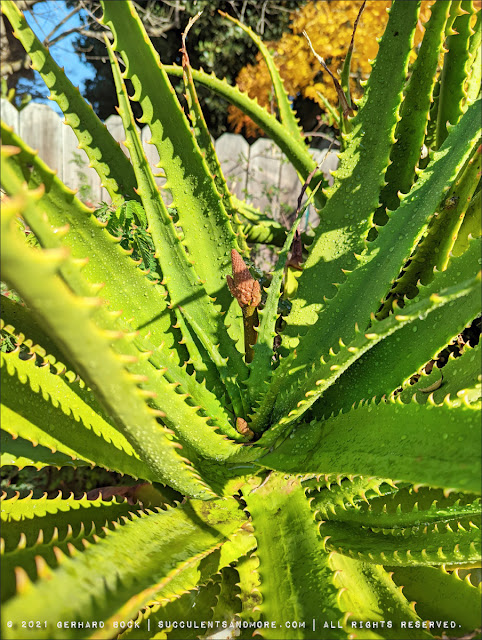Mealybugs (grrrr) on my 2nd tallest aloe
Mealybugs are the most persistent pest in our garden. Like aphids, they're often farmed by ants who feed on the sugary waste the mealybugs produce. And since Davis is built on a giant ant hill, as I like to say, ants and mealybugs are a fact of life.
Typically, mealybugs are the most active—and hence the biggest problem—from late spring to late fall when it's warm and dry. Mealybugs cannot survive freezing temperatures, but since we rarely have hard frosts, I suppose they just hunker down in their cottony cocoons.
It may be December, but the days have been sunny and warm. I'm sure that suits the mealybugs just fine. They don't seem to be inclined to go into hibernation just yet. In fact, to my surprise, I noticed quite an infestation in our second tallest aloe, 'Erik the Red'.
From a distance, 'Erik the Red' looks great:
But look inside the center of this one rosette:
And behind it:
I have no clue why mealybugs prefer 'Erik the Red'. We have many different aloes in our garden, and only a few of them are mealybug targets (Aloe vaombe and Aloe excelsa are two others).
My first line of treatment is a strong spray of water. This is an easy way to get rid of the infestation, but of course only in the spots where the water goes.
This is the same rosette you saw earlier after cleaning (notice two inflorescences emerging):
While water gets rid of lot of the bugs, it's never completely effective. Plus, 'Erik the Red' is too tall now for me to thoroughly clean all the rosettes. That's why I decided to add a second line of treatment: a systemic insecticide. I don't resort to chemicals casually, but enough is enough.
Bayer's BioAdvanced 12-Month Tree & Shrub Protect & Feed is a mouthful, but many people swear by it, so that's what I used. That's what the bucket you see in the photo below is for. I filled it with 2 gallons of water and added the recommended amount of concentrate. The bucket has a few small holes that allow the solution to trickle out. If I had poured it out all at once, some of it would have run off, seeing how the mound is sloped towards the sidewalk.
I'm also going to treat the Aloidendron 'Hercules' in the same bed. It's 10 ft. tall now and there's no way I can look inside the rosette. However, I've seen ants crawling up its trunk, so it's possible there's a mealybug colony among the leaves.
Of course, the best thing to do would be to get rid of the ants, but that's a futile undertaking, considering they're everywhere, not just in our garden.
© Gerhard Bock, 2021. All rights reserved. To receive all new posts by email, please subscribe here.






I rarely use chemicals in the garden but occasionally they are called for. Hopefully the systemic will do the trick. All my succulents have to come indoors for the winter so mealybug is a problem no matter how carefully I check them first. Unless it's something really special if the plant is infested it goes out the door onto 'death row'. -20 quickly fixes them. Ha!
ReplyDeleteI hate the cold, but I sometimes wish we had a good cold snap to wipe out mealybugs and similar bugs :-)
DeleteMealy bugs... treacherous creatures! Portland shares your ant issue so naturally the mealy bugs are as well. Interestingly I've never had them show up on an aloe, they prefer agaves and bromeliads.
ReplyDeleteJust like with aloes, mealybugs seem to infest some agaves, but not others. Agave parryi and its many forms are a magnet, for some reason...
DeleteOn a tour I visited a private succulent garden in SoCal a while back, mostly aloes, and was naively surprised to hear he had pesticide help come out once a month to manage these issues. I wonder how my 'Goliath' is doing in my absence without daily vigilance...
ReplyDeleteYep, it's a not so closely kept secret. But seriously, what else are you going to do?
DeleteI hate those damn things ! When I find mealybugs they are usually on succulents -if it's something small-ish easily replaced I usually just toss it. Otherwise it's the alcohol-Q-tip treatment. I've thrown in the towel on most Semps due to persistant MB invasions.
ReplyDeleteSemps are a lost cause, except for arachnoideum, which does much better--maybe because of the "spider webs?"
DeleteAll we can do is be vigilant. Part of the benefit of just walking around the garden looking--it's more than just fun!
ReplyDeleteThe Bayer is also apparently effective for aloe gall mite. I spray rubbing alcohol at times for aphids and mealies, but repeated treatment needed. They seem much more prevalent in potted plants than the ones in the ground.
Have had the cochineal scale appearing and then completely vanishing from an agave here and there--something is either killing or eating them---but what???
I just found more evidence of mealybugs on Aloe vaombe. Decided to spray with alcohol because it's about to flower for the first time.
DeleteI've never had cochineal scale on anything but opuntias. But now that I've said it, I probably will, ha ha.